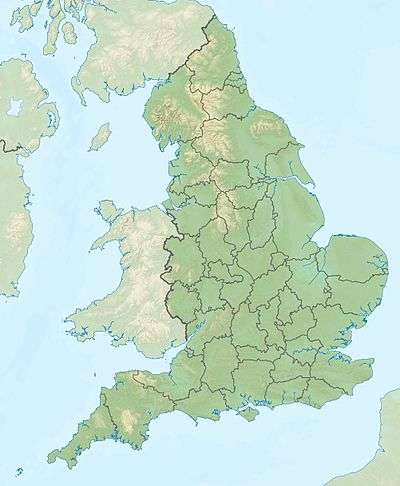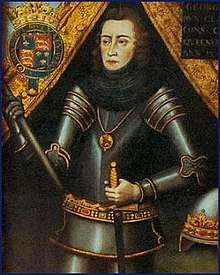Battle of Edgecote Moor
The Battle of Edgecote Moor took place on 26 July 1469, during the Wars of the Roses. It was fought between a Royal army, commanded by the earls of Pembroke and Devon, and a rebel force led by supporters of the Earl of Warwick.
| Battle of Edgecote Moor | |||||||
|---|---|---|---|---|---|---|---|
| Part of Wars of the Roses | |||||||
_-_geograph.org.uk_-_815349.jpg) Danesmoor, site of the battle | |||||||
| |||||||
| Belligerents | |||||||
|
Duke of Clarence Earl of Warwick | Edward IV | ||||||
| Commanders and leaders | |||||||
|
| ||||||
| Strength | |||||||
| Estimated 10,000 - 15,000 |
Pembroke; estimated 5,000 - 6,000 Devon; estimated 5,000 - 7,000[1] | ||||||
| Casualties and losses | |||||||
| unknown | 168 knights and gentry, ca 2,000 others[2] | ||||||
The battle took place 6 miles (9.7 km) northeast of Banbury in Northamptonshire; while it resulted in a rebel victory, it had little impact on the overall political situation. By September, Edward was back in control.
Edgecote is one of the least well-documented battles of the period; accounts diverge in terms of numbers, leaders, casualties, and the course of the fighting. The heavy casualties suffered by Pembroke's Welsh forces made it a popular topic for Welsh poets.
Background

Close allies in deposing Henry VI in 1461, by 1469 Warwick and Edward IV had fallen out. After marrying Elizabeth Woodville in 1464, Edward increasingly relied on her family, who competed with the Nevilles for lands and positions. Concerned by his close connection with Warwick, Edward blocked a proposed marriage between Clarence, his younger brother and heir, and Warwick's eldest daughter Isabel. For various reasons, Clarence greatly resented this.[3]
In April 1469, a revolt broke out in Yorkshire, under a leader called Robin of Redesdale. His true identity is unknown, but is thought to have been either Sir John Conyers, steward of Warwick's Middleham Castle, his brother Sir William Conyers of Marske (d. 1469), or both.[4] In May, a second rebellion began, led by a figure known as Robin of Holderness, demanding the restoration of Henry Percy, traditional Earl of Northumberland.[5]
John Neville, the current Earl, quickly suppressed this and executed its leader, although he made little attempt to intercept Robin of Redesdale.[5] Confident the rebellion was well in hand and accompanied only by his personal household troops, Edward moved slowly north through Lincolnshire, reaching Crowland in early July. On 9 July, he discovered the rebel army was considerably larger than previously advised, followed by even more disturbing news from London.[6]
Warwick and Clarence spent the summer assembling troops, allegedly to help suppress the revolt; in early July, they traveled to Calais, where Clarence married Isabel in a ceremony conducted by Warwick's brother George, Archbishop of York. The three men then issued a 'remonstrance', listing alleged abuses by the Woodvilles, William Herbert, Earl of Pembroke and Humphrey Stafford, Earl of Devon among others. They entered London on 12 July, and on 18th, marched north with to link up with the Yorkshire rebels.[7]
Edward withdrew to Nottingham and sent urgent instructions to Pembroke in Raglan Castle and Devon in Dorchester, ordering them to meet him there with as many men as they could muster. The northern rebels headed for Northampton, intending to link up with Warwick and Clarence and late in the afternoon of 24 July, fought a brief skirmish north of Banbury with the Royal army. Pembroke and Devon withdrew to Banbury, where Sir Henry Neville, captured in the skirmish, was executed that same evening; however, after a quarrel over accommodation, Devon took his troops to Deddington Castle, ten miles away.[8]
The battle

Estimates suggest Pembroke had some 3,000 to 6,000 Welsh knights and spearmen, with 3,000 to 7,000 under Devon, including most of the archers. Aware of the need to destroy the northern army before they were reinforced, Pembroke left Banbury on 25 July and camped overnight on high ground to the north-east. This overlooked the site of the 914 CE Battle of Danes Moor, with the two armies separated by a tributary of the River Cherwell.[9][10]
The rebel army contained a large contingent of archers, putting Pembroke at a disadvantage; he ordered his troops forward and the two sides fought at close quarters for the rest of the morning. By early afternoon, the Royal army had gained control of the river crossing, but at this point, Warwick's advance guard arrived upon the field, led by Sir Geoffrey Gate and Sir William Parr.[7]
While accounts vary, it appears Devon assumed this was Warwick's entire army and withdrew; under severe pressure, Pembroke's men broke. Casualties were reported as 168 knights and gentry, plus 2,000 rank and file, losses significant enough to be remembered and referenced by Welsh poets a century later.[11][12] Pembroke and his brother Sir Richard Herbert were captured and executed at Northampton the following day; their half brother Sir Richard Vaughan died during the battle and Devon was beheaded at Bridgwater on 17 August.[13]
There are few details on rebel casualties but they would have been considerably less than those suffered by Pembroke since most deaths occurred during a pursuit. Apart from Henry Neville, executed on 24 July, these included Sir William Conyers, and Sir Oliver Dudley, youngest son of John Sutton, 1st Baron Dudley.[2]
Aftermath

Edward was taken into custody and held in Middleham Castle. On 12 August, his father-in-law Earl Rivers and younger son John Woodville were executed at Kenilworth, following a summary trial. However, it soon became clear there was little support for Warwick or Clarence; Edward was released in September and resumed the throne.[5]
Richard Herbert was buried in the Herbert chapel at Abergavenny Priory, which survived the damage caused during the Dissolution of the Monasteries in 1536 to 1541. It also includes the tomb of William Herbert's illegitimate son, Richard Herbert of Ewyas, who was brought up with Henry Tudor, later Henry VII and fought on his side at Bosworth in 1485.[14]
Commemoration and re-enactments
On 12 and 13 September 2009 there was a re-creation of the battle on the actual battlefield, staged by the Medieval Siege Society and the English Tournament Society to commemorate the 540th anniversary.
Following the success of the 2009 commemoration and re-enactment, a second recreation was staged on 11 and 12 September 2010 for the 541st anniversary.
Since 2009, an annual walk of the battlefield and the key sites has taken place on the Sunday closest to the anniversary. The walk pauses at the Trafford Bridge site to lay a wreath remembering all those that lost their lives from both sides. This is also organised by the Medieval Siege Society.
References
- "Battle of Edgecote". Battlefields Trust. Retrieved 3 December 2019.
- "The Battle of Edgecote". Luminarian Encyclopedia Project. Retrieved 4 December 2019.
- Penn 2019, pp. 203-205.
- Gillingham 1982, p. 161.
- Gillingham 1982, p. 160.
- Penn 2019, pp. 208-209.
- Penn 2019, pp. 210-211.
- "The Battle of Edgecote Moor". Englishmonarchs.com. Retrieved 4 December 2019.
- Weir 1995, pp. 351-352.
- Evans 2019, pp. 29-43.
- Lewis 2011, p. 112.
- Evans 2019, p. 10.
- Weir 1995, p. 352.
- "St Mary's Priory". St Mary's. Retrieved 6 December 2019.
Sources
- Evans, Graham (2019). The Battle of Edgcote 1469. Northamptonshire Battlefields Society. ISBN 978-1794611078.CS1 maint: ref=harv (link)
- Gillingham, John (1982). The Wars of the Roses (1990 ed.). Weidenfeld & Nicolson. ISBN 978-0297820161.CS1 maint: ref=harv (link)
- Lewis, Barry (2011). Curry, Anne; Bell, Adrian (eds.). The Battle of Edgecote through Welsh Eyes in Soldiers, Weapons and Armies in the Fifteenth Century. Boydell Press. ISBN 978-1843836681.CS1 maint: ref=harv (link)
- Penn, Thomas (2019). The Brothers York: An English Tragedy. Allen Lane. ISBN 978-1846146909.CS1 maint: ref=harv (link)
- Weir, Alison (1995). Lancaster & York; the Wars of the Roses (2009 ed.). Vintage. ISBN 978-0099540175.CS1 maint: ref=harv (link)
External links
- "St Mary's Priory". St Mary's. Retrieved 6 December 2019.
- "Battle of Edgecote". Battlefields Trust. Retrieved 3 December 2019.
- "The Battle of Edgecote Moor". Englishmonarchs.com. Retrieved 4 December 2019.
- "The Battle of Edgecote". Luminarian Encyclopedia Project. Retrieved 4 December 2019.
